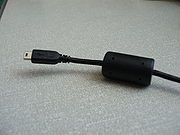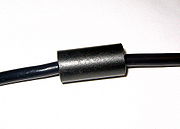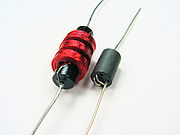
Ferrite bead
Encyclopedia



Electronic noise
Electronic noise is a random fluctuation in an electrical signal, a characteristic of all electronic circuits. Noise generated by electronic devices varies greatly, as it can be produced by several different effects...
in electronic circuits. It is a specific type of electronic choke
Choke (electronics)
A choke is a coil of insulated wire, often wound on a magnetic core, used as a passive inductor which blocks higher-frequency alternating current in an electrical circuit while passing signals of much lower frequency and direct current by having an impedance largely determined by reactance, which...
. Ferrite beads employ the mechanism of high dissipation of high frequency currents in a ferrite
Ferrite (magnet)
Ferrites are chemical compounds consisting of ceramic materials with iron oxide as their principal component. Many of them are magnetic materials and they are used to make permanent magnets, ferrite cores for transformers, and in various other applications.Many ferrites are spinels with the...
to build high frequency noise suppression devices. Ferrite beads may also be called ferrite blocks, ferrite cores, ferrite rings, ferrite EMI filters, ferrite chokes or ferrous beads.
Overview
Ferrite beads are used (in a way similar to inductorInductor
An inductor is a passive two-terminal electrical component used to store energy in a magnetic field. An inductor's ability to store magnetic energy is measured by its inductance, in units of henries...
s) as a passive low-pass filter
Low-pass filter
A low-pass filter is an electronic filter that passes low-frequency signals but attenuates signals with frequencies higher than the cutoff frequency. The actual amount of attenuation for each frequency varies from filter to filter. It is sometimes called a high-cut filter, or treble cut filter...
. The geometry and electromagnetic properties of coiled wire over the ferrite bead result in a high resistive impedance
Electrical impedance
Electrical impedance, or simply impedance, is the measure of the opposition that an electrical circuit presents to the passage of a current when a voltage is applied. In quantitative terms, it is the complex ratio of the voltage to the current in an alternating current circuit...
(resistance
Electrical resistance
The electrical resistance of an electrical element is the opposition to the passage of an electric current through that element; the inverse quantity is electrical conductance, the ease at which an electric current passes. Electrical resistance shares some conceptual parallels with the mechanical...
) for high-frequency signals, attenuating high frequency EMI
Electromagnetic interference
Electromagnetic interference is disturbance that affects an electrical circuit due to either electromagnetic induction or electromagnetic radiation emitted from an external source. The disturbance may interrupt, obstruct, or otherwise degrade or limit the effective performance of the circuit...
/RFI electronic noise. The energy is either reflected back up the cable, or absorbed resistively within the ferrite core and dissipated as low level heat. Only in extreme cases will the heat be noticeable.
A pure inductor does not dissipate energy; it merely absorbs energy from the circuit and returns it at a later time. A ferrite bead, by design, filters out the high frequency noise in the circuit by dissipating it as heat. The ferrite bead is effectively an inductor with a very small Q factor. When electrical noise within the target frequency range travels in the signal cable a back-emf is induced in the ferrite bead because of its high inductance. The material used to construct the ferrite bead however, becomes highly resistive at the design frequency range (the magnetic field within the bead is unable to establish properly at that specific frequency range) and the induced current inside the bead is dissipated as heat instead of inducing an opposing current back in the signal cable. It is for this reason that the specific circuit characteristics as well as the frequency band of the noise need to be taken into account when the ferrite bead is installed as a noise filter.
Ferrite beads are one of the simplest and least expensive types of interference filters to install on preexisting electronic cabling. For a simple ferrite ring, the wire is simply wrapped around the core through the center typically 5 or 7 times. Clamp-on cores are also available, which can be attached without wrapping the wire at all. Although the wire is not coiled around the core for this type of ferrite beads, the introduction of the ferrite core around the wire increases the self-inductance of the wire and thus still has the effect of absorbing energy from the noise traveling in the wire. If the fit is not snug enough, the core can be secured with cable tie
Cable tie
A cable tie, also known as a zip tie or tie-wrap , is a type of fastener, especially for binding several electronic cables or wires together and to organize cables and wires.-Design and use:...
s, or if the center is large enough, have the cabling looped through one or more times.
See also
- BalunBalunA balun is a type of electrical transformer that can convert electrical signals that are balanced about ground to signals that are unbalanced , and the reverse. They are also often used to connect lines of differing impedance...
- Electromagnetic interferenceElectromagnetic interferenceElectromagnetic interference is disturbance that affects an electrical circuit due to either electromagnetic induction or electromagnetic radiation emitted from an external source. The disturbance may interrupt, obstruct, or otherwise degrade or limit the effective performance of the circuit...
- Ferrite (magnet)Ferrite (magnet)Ferrites are chemical compounds consisting of ceramic materials with iron oxide as their principal component. Many of them are magnetic materials and they are used to make permanent magnets, ferrite cores for transformers, and in various other applications.Many ferrites are spinels with the...
- Ferrite (iron)Ferrite (iron)Ferrite or alpha iron is a materials science term for iron, or a solid solution with iron as the main constituent, with a body centred cubic crystal structure. It is the component which gives steel and cast iron their magnetic properties, and is the classic example of a ferromagnetic material...
- Ferrite coreFerrite coreA ferrite core is a structure on which the windings of electric transformers and other wound components such as inductors are formed. It is used for its properties of high magnetic permeability coupled with low electrical conductivity .There are two broad applications for ferrite cores which...
- Magnetic coreMagnetic coreA magnetic core is a piece of magnetic material with a high permeability used to confine and guide magnetic fields in electrical, electromechanical and magnetic devices such as electromagnets, transformers, electric motors, inductors and magnetic assemblies. It is made of ferromagnetic metal such...
- Toroidal inductors and transformersToroidal inductors and transformersToroidal inductors and transformers are electronic components, typically consisting of a circular ring-shaped magnetic core of iron powder, ferrite, or other material around which wire is coiled to make an inductor. Toroidal coils are used in a broad range of applications, such as high-frequency...
- Unintentional radiatorUnintentional radiatorAn unintentional radiator or Incidental radiator is any device which creates radio frequency energy within itself, which is then unintentionally radiated from the device...
External links
- An explanation of the physics behind ferrite beads
- What are the bumps at the end of computer cables?
- Understanding Ferrite Bead Inductors, by Murata ManufacturingMurata Manufacturingis a Japanese manufacturer of electronic components, based in Nagaokakyo, Kyoto.Honorary Chairman Akira Murata started Murata Manufacturing as a personal venture in October, 1944. On December, 1950 reorganized the company into Murata Manufacturing Co., Ltd...
- How to use ferrites for EMI suppression by Fair-Rite
- Tekzilla Daily Episode 13, short video podcast with explanation

